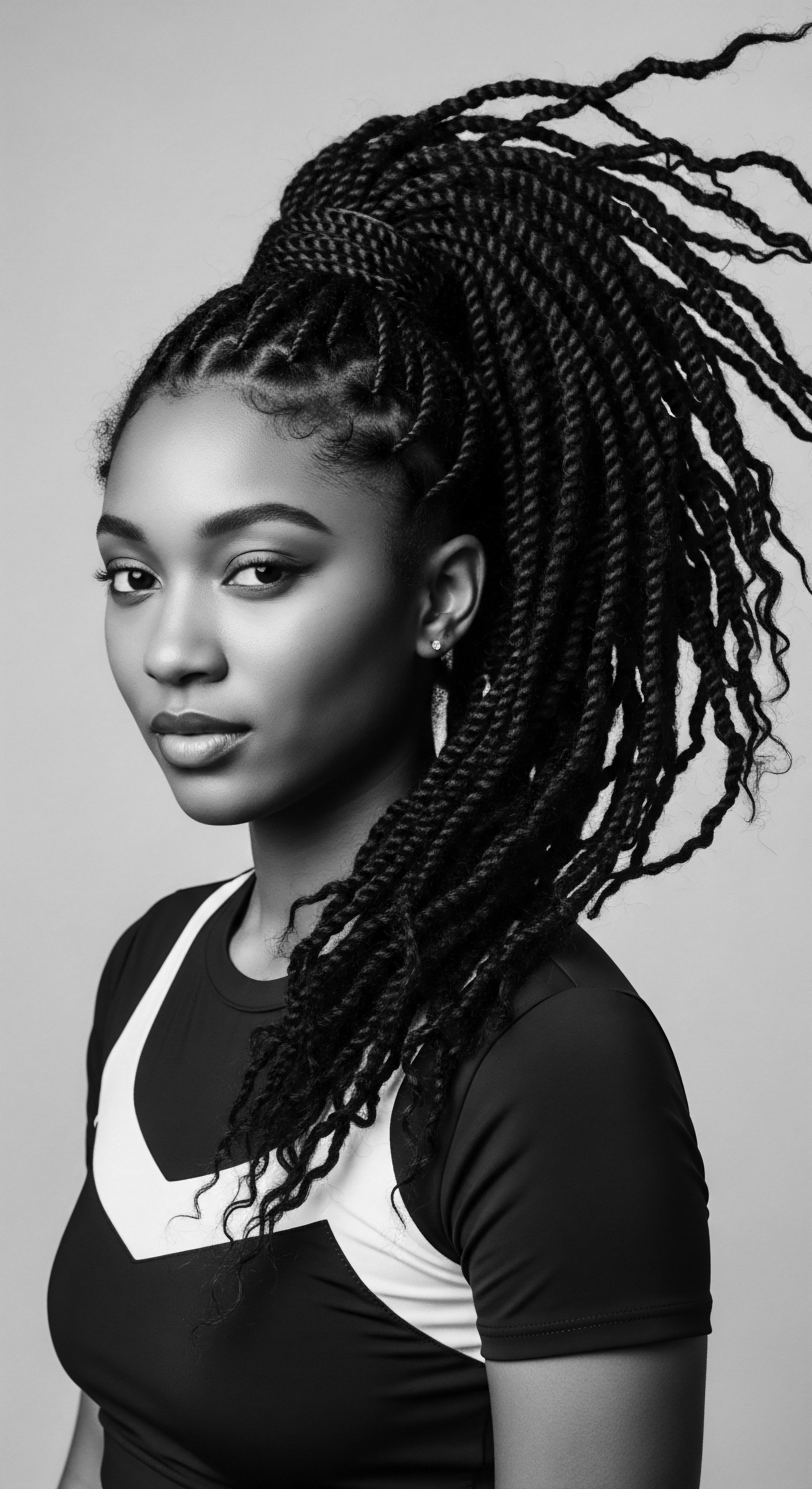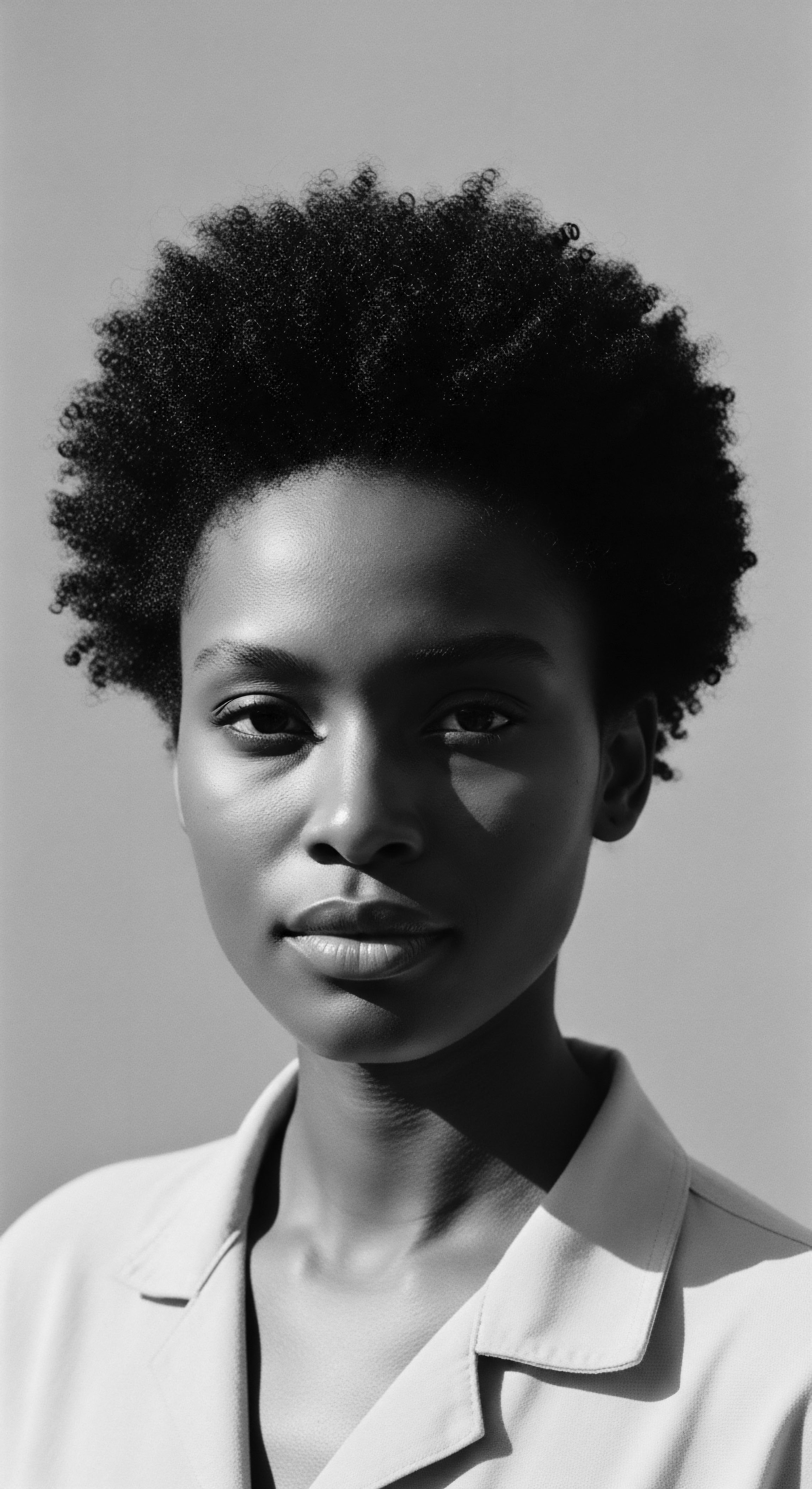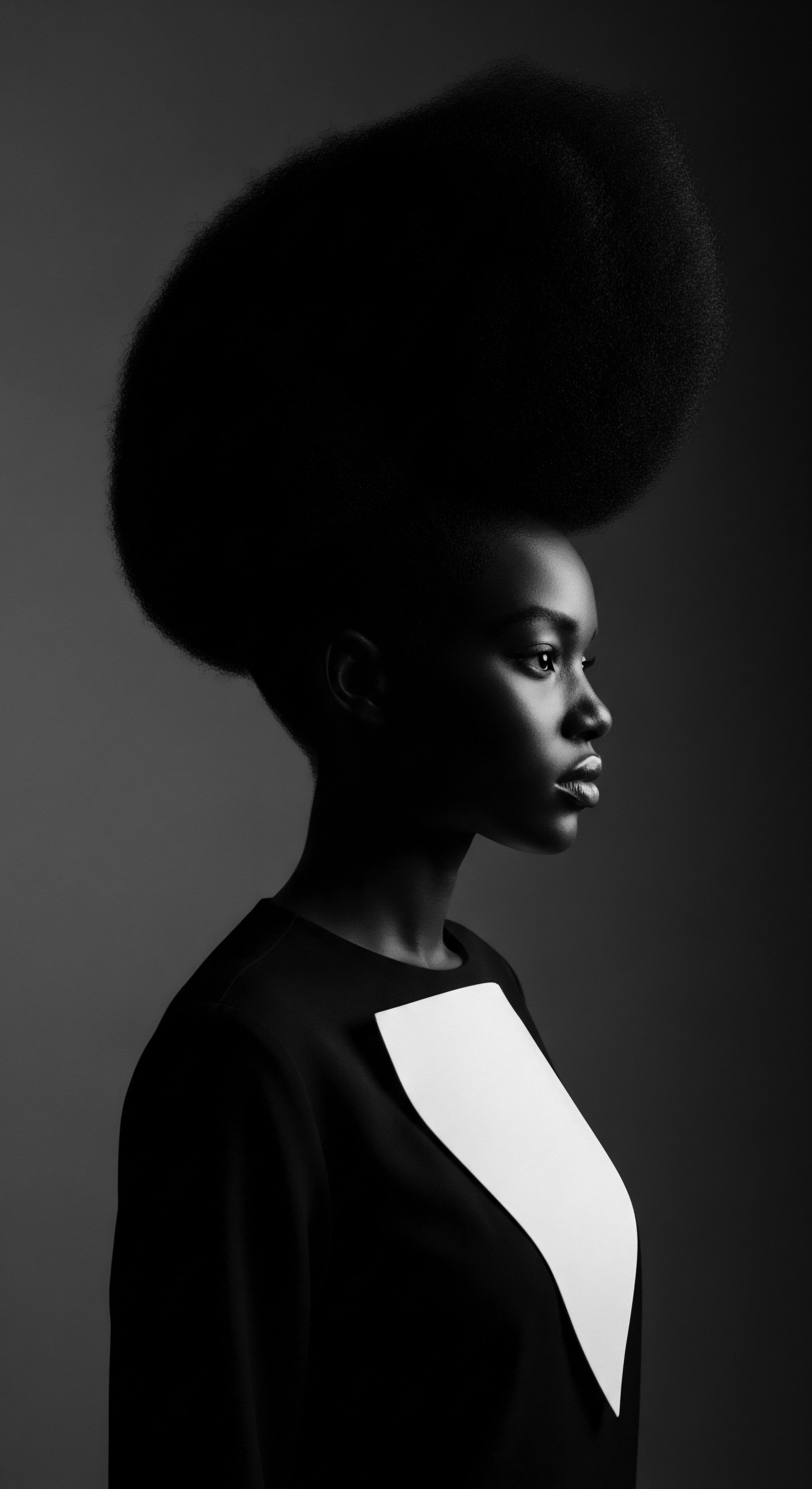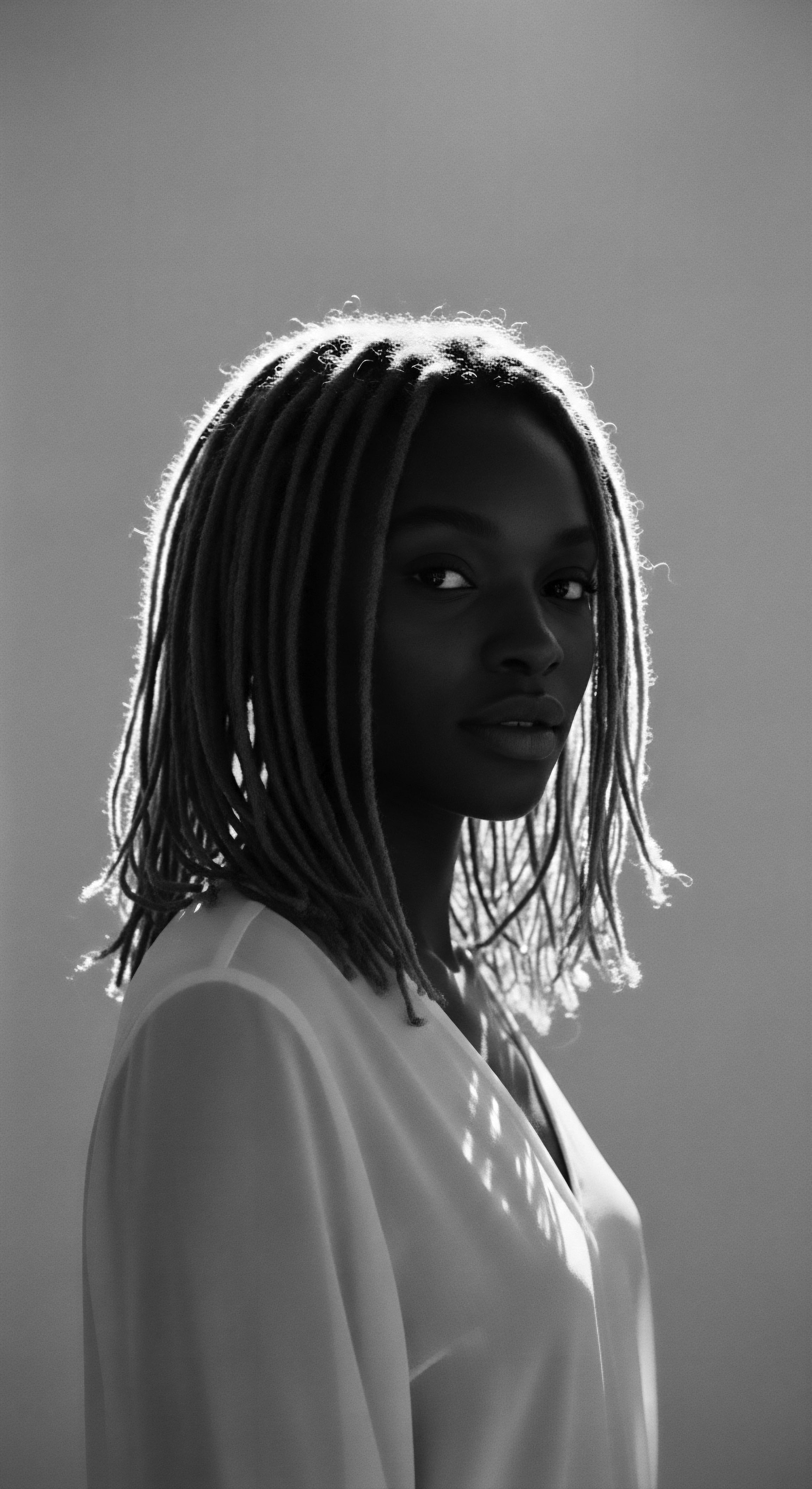
Roots
The coil, the curl, the wave—these are not mere textures of hair. They are narratives etched in time, living archives of ancestry, resilience, and identity. For those with textured scalps, the very foundation of vibrant strands begins with deep, intentional hydration, a wisdom passed down through generations.
This is not about surface-level shine or fleeting trends; it connects to the rich heritage that understands hair as a crown, a connection to the past, and a declaration for the future. We look to the elemental oils, those gifts from ancient earth, that have cradled and sustained textured scalps for millennia.

The Architecture of Coils and Curls
Textured hair, with its unique helical structure, presents a distinct challenge and opportunity for hydration. Unlike straight hair, the natural twists and turns of a coil mean that the scalp’s own conditioning oil, Sebum, finds it more difficult to travel the full length of the hair strand. This often leaves the ends more susceptible to dryness and breakage. This inherent characteristic of textured hair, so celebrated in many cultures, also means its care requires specialized attention.
Our ancestors understood this deeply, long before microscopes revealed the intricate cross-sections of an elliptical hair shaft. They observed the hair, felt its needs, and responded with treatments that spoke to its thirst.
Hair classification systems, while attempting to categorize the broad spectrum of textured hair, often fail to capture the profound variations that exist within families and communities. The journey of understanding textured hair begins not with a chart, but with reverence for its diversity. We acknowledge that hair, like identity, resists simple boxes.
Ancestral oils offer more than moisture; they represent a deep knowledge of textured hair’s distinctive needs, a wisdom passed through generations.

The Scalp’s Ancient Ecology
The scalp is the soil from which our hair grows. A well-tended scalp, nourished and balanced, is fundamental to the vitality of textured strands. Ancestral practices consistently paid close attention to the scalp, recognizing its central role in hair health.
Many historical oiling rituals were not just about the hair itself, but about massaging the oil into the scalp, stimulating circulation and providing a protective, soothing layer. This preventative care, designed to safeguard the skin of the scalp from dryness and irritation, allowed hair to flourish.
The science of hydration today speaks of occlusives and emollients . Occlusives create a barrier that holds moisture within the hair shaft and scalp, slowing evaporation. Emollients work to smooth and soften the hair’s surface.
Ancestral oils often possess both qualities, acting as a complete system of hydration. They are not merely cosmetic additions; they are fortifiers.
Understanding the hair growth cycle also allows us to appreciate the longevity of ancestral practices. Hair goes through stages of growth (anagen), regression (catagen), and rest (telogen). Consistent, gentle care, supported by the right oils, can help optimize these cycles, promoting strong, healthy growth from the root. This continuous cycle of regeneration has always been central to care practices across Black and mixed-race communities, linking daily rituals to the ongoing story of lineage.

The Language of Hair ❉ From Classification to Kinship?
How did our ancestors speak of hair, beyond simple descriptions? The terms used often reflected a profound connection to nature, to community, and to the living world around them. While modern classifications sometimes categorize hair into types, traditional African societies, for example, often used descriptive terms that linked hair to identity, social status, or even spiritual meaning.
This holistic view of hair meant that care practices, including oiling, were not isolated acts. They were interwoven with cultural understanding, communal bonding, and a reverence for the body.
The essential lexicon of textured hair includes terms that speak to its strength, its coils, and its natural beauty. In various West African cultures, hair was meticulously styled and adorned, and oils were indispensable to maintaining these elaborate creations. The very act of oiling could be a social event, a moment of connection between mothers, daughters, and friends, where stories were shared and traditions passed down. This human element, the touch and shared wisdom, is a core part of hair’s ancestral story.

Ritual
The application of ancestral oils to textured hair has always extended beyond mere function. It is a ritual, a mindful act, steeped in cultural significance and a profound understanding of hair’s inherent nature. This is the tender thread, linking generations through shared practices that honor hair’s strength and beauty. From the gentle parting of strands to the deliberate massage of the scalp, these techniques transform a simple act of conditioning into a ceremony of connection, echoing traditions born from necessity and elevated to artistry.

The Hand and the Strand ❉ Ancestral Oiling Practices
Across the African continent and its diaspora, the rhythmic motions of oiling hair have been a consistent practice for centuries. This was often done not merely for aesthetic purposes, but as a protective measure against environmental challenges such as dry climates and intense sun. The hands, the earliest and most intuitive tools, applied these sacred oils with purpose. Palm oil , for instance, has been a traditional staple across West African communities for both culinary use and deeply conditioning skin and hair.
Its rich composition offered vital protection. Similarly, the meticulous practice of Hair Oiling in South Asian cultures, often involving warm Coconut Oil massaged into the scalp, dates back centuries. It serves as a wellness practice and a bonding experience within families (Her Campus, 2024; Fluent Health, 2024).
The practices involved:
- Sectioning ❉ Hair was often divided into smaller sections, allowing for even distribution of the oil from root to tip. This methodical approach ensured every coil received attention.
- Scalp Massage ❉ Beyond hydrating the strands, significant attention was given to massaging oils into the scalp. This was believed to stimulate circulation, promote a healthy scalp environment, and even encourage growth. It was a sensory experience, calming and restorative.
- Overnight Treatments ❉ Many traditions involved leaving oils on the hair overnight, allowing for deeper penetration and conditioning. This prolonged contact maximized the benefits of the oils.
The historical use of specific oils for textured hair reveals an ingenious synergy between available resources and the unique biological needs of coily and curly strands.
These practices were not isolated; they were interwoven with daily life, sometimes performed during communal gatherings, sharing wisdom and strengthening bonds.

Styles as Storytellers ❉ Oils in Protective Forms
Protective styles—braids, twists, cornrows, and buns—are ancient forms of hair artistry that shield textured hair from environmental damage and mechanical stress. Ancestral oils were indispensable partners in creating and maintaining these styles. They provided the lubrication needed to minimize friction during styling, reducing breakage, and lending a healthy sheen. They also helped to seal in moisture, keeping the hair supple within its protective casing.
Consider the intricate braiding styles of various African ethnic groups, which could communicate social status, marital status, or even one’s lineage (Salford Students’ Union, 2024; National Museum of American History, 2024). Oils like Shea Butter or various plant oils were applied during the braiding process to ensure the hair remained soft and pliable, preventing the dryness that could lead to discomfort or damage. These oils were a crucial component of the style itself, providing a foundational layer of care that supported the hair’s integrity while it told its story.

Tools of Tradition ❉ Enhancing Oiled Strands
While the hands were primary, traditional tools also played a role in amplifying the effects of ancestral oils. Combs carved from wood or bone, simple yet effective, helped distribute oils and detangle strands gently. Headwraps and scarves, far from mere adornment, were often used to protect oiled hair, especially overnight, ensuring the moisture remained sealed in.
This practice also prevented oils from transferring to sleeping surfaces, a pragmatic consideration. These accessories, often vibrantly colored or intricately patterned, served as both functional elements of hair care and expressions of cultural pride.

Relay
Our journey through the heritage of textured hair care now brings us to the specific oils that have stood the test of time, carrying ancestral wisdom within their very composition. This exploration moves beyond general practices, delving into the science that now validates what our forebears understood intuitively. We examine how these oils, sourced from the earth’s bounty, hydrate textured scalps, fostering health and celebrating the inherent strength of our strands.

Liquid Gold from Ancient Earths ❉ Specific Oil Lineages
The earth has always provided remedies, and for textured hair, certain ancestral oils stand out for their exceptional hydrating qualities. These are not arbitrary selections; they are ingredients deeply woven into the histories of Black and mixed-race communities worldwide.
- Shea Oil and Butter ❉ Originating from the shea tree native to West Africa, shea butter (often processed into an oil) has been a cornerstone of skin and hair care for centuries. It’s often called “women’s gold” in West African communities due to its economic significance and the fact that its production is primarily controlled by women (Thirteen Lune, 2024; Ciafe, 2023). Rich in vitamins A and E, it offers remarkable moisturizing and healing properties. For textured scalps, shea oil forms a protective, occlusive layer, preventing moisture loss and soothing irritation. Its traditional use extends to newborns and wedding preparations, highlighting its deep cultural embeddedness (Thirteen Lune, 2024; Goyum Screw Press, 2025).
- Jamaican Black Castor Oil ❉ This distinct oil, processed through a unique roasting and boiling method in Jamaica, holds profound significance. Its origins trace back to Africa, brought to the Caribbean during the transatlantic trade (Kuza Products, 2023; Makeup.com, 2023). Used for millennia by Ancient Egyptians, its re-introduction and traditional processing in Jamaica cemented its place in the island’s cultural heritage. Jamaican Black Castor Oil is praised for its rich Ricinoleic Acid content, which supports scalp circulation and offers deep hydration, making it a staple for those with coily hair types prone to dryness (Kuza Products, 2023; Prose, 2023).
- Coconut Oil ❉ A cherished ingredient in South Asia and tropical regions, coconut oil has been a central part of hair care rituals for generations. Families warm the oil and massage it into the scalp as a regular practice, often on Sundays, hours before washing it out (Her Campus, 2024). Its molecular structure, particularly its high content of lauric acid, allows it to penetrate the hair shaft, providing nourishment deep within. This penetration sets it apart, offering conditioning that many synthetic alternatives cannot replicate (Fluent Health, 2024; Hair by Clare, 2023).
- Baobab Oil ❉ Extracted from the seeds of Africa’s “Tree of Life,” the baobab, this oil is a powerhouse of essential fatty acids (omega-3, 6, and 9) and vitamins (A, D, E, and F). Communities in Burkina Faso, for instance, have harvested baobab fruits for centuries, extracting the oil using traditional cold-pressing methods that empower local women (Prose, 2023). Baobab oil is celebrated for its ability to infuse hair with nutrients, strengthen fibers, and lock in moisture, offering significant benefits for dry, brittle strands (NATURAL POLAND, 2023; Healthline, 2020).
- Olive Oil ❉ With a history dating back over 2,000 years in the Mediterranean and North Africa, olive oil was a beauty secret of ancient Greeks, Romans, and Egyptians (Vertex AI Search, 2024; Seek Bamboo, 2024). Cleopatra herself was said to use it for lustrous hair (Vertex AI Search, 2024). Its rich antioxidant content helps protect hair from environmental damage, while its emollient properties provide deep conditioning, a practice still popular today (Vertex AI Search, 2024; Seek Bamboo, 2024).
The deep reverence for these botanical gifts speaks to a reciprocal relationship with the earth, one that valued sustainability and traditional knowledge long before these terms became widely known.

The Science Whispers ❉ How Ancestral Oils Hydrate?
The efficacy of ancestral oils in hydrating textured scalps finds confirmation in modern scientific understanding. These oils are typically rich in specific fatty acids that interact harmoniously with the hair’s natural structure.
A table outlining the properties of some ancestral oils and their mechanisms of hydration:
| Ancestral Oil Shea Oil / Butter |
| Region of Heritage West Africa |
| Primary Hydration Mechanism Forms occlusive barrier, rich emollients |
| Key Fatty Acids / Components Stearic, Oleic, Linoleic, Palmitic acids, Vitamin A & E |
| Ancestral Oil Jamaican Black Castor Oil |
| Region of Heritage Caribbean (African Diaspora) |
| Primary Hydration Mechanism Occlusive barrier, ricinoleic acid (humectant-like effect by drawing moisture) |
| Key Fatty Acids / Components Ricinoleic acid (85-95%), Omega-6, Omega-9 |
| Ancestral Oil Coconut Oil |
| Region of Heritage South Asia, Tropical Regions |
| Primary Hydration Mechanism Penetrates hair shaft, reduces protein loss, occlusive |
| Key Fatty Acids / Components Lauric acid (high affinity for hair protein) |
| Ancestral Oil Baobab Oil |
| Region of Heritage African Savannahs |
| Primary Hydration Mechanism Moisture retention, strengthens hair fibers |
| Key Fatty Acids / Components Omega-3, Omega-6, Omega-9 fatty acids, Vitamins A, D, E, F |
| Ancestral Oil Olive Oil |
| Region of Heritage Mediterranean, North Africa |
| Primary Hydration Mechanism Emollient, antioxidant protection, some occlusive properties |
| Key Fatty Acids / Components Oleic acid, Linoleic acid, Vitamin E, Polyphenols |
| Ancestral Oil These oils offer multi-faceted hydration, reflecting centuries of practical wisdom. |
The molecular weight of the fatty acids within these oils matters significantly. For example, coconut oil, with its smaller molecular size (due to a high percentage of lauric acid ), can penetrate the hair shaft itself, offering deep conditioning (Fluent Health, 2024; Hair by Clare, 2023). Other oils, such as shea butter and castor oil, primarily act as occlusives.
They create a protective film over the hair and scalp, reducing transeansepidermal water loss. This layering of different oil types, whether through traditional mixtures or modern formulations, allows for comprehensive hydration, addressing both the internal structure of the hair and its external protection.
The molecular structure of ancestral oils often complements the unique needs of textured hair, confirming long-held traditional knowledge.

Beyond the Strand ❉ Oils and Ancestral Wellness
The concept of hair care in ancestral traditions was rarely isolated from overall wellbeing. It connected to a holistic view of the body, mind, and spirit. The act of oiling was often a soothing, grounding practice, promoting not only physical health but also mental tranquility. This interconnectedness is a profound aspect of heritage.
Many ancestral oils possess properties beyond simple hydration. For example, baobab oil’s anti-inflammatory properties can soothe an irritated scalp (Healthline, 2020). Jamaican Black Castor Oil is noted for its ability to support a healthy scalp environment (Kuza Products, 2023).
This multifaceted action reinforces the idea that these oils were chosen not just for one specific benefit, but for their overall contribution to scalp and hair vitality, viewed through the lens of complete human wellness. The knowledge passed down through generations often included understanding the synergistic effects of various plants and their extracts, creating remedies that worked on multiple levels.

Reflection
The journey through ancestral oils and their deep connection to textured scalps is a profound meditation on heritage. It highlights how the wisdom of generations, forged through intimate connection with nature and shared communal practices, holds powerful answers for present-day care. The simple act of applying oil to hair becomes a whispered conversation across time, acknowledging the ingenuity and resilience of those who came before us. It reminds us that our strands are not just protein and moisture; they are living testaments to lineage, cultural memory, and enduring beauty.
Roothea’s very soul resides in this understanding. We find not merely ingredients in these oils, but stories, a living archive of resilience and creativity. As we continue to seek vibrant hair health, we stand on the shoulders of giants, drawing from the boundless wellspring of ancestral knowledge.
The whispers of the past, carried on the breeze through ancient groves of shea and baobab, in the scent of coconut and the richness of castor, guide our hands. This heritage is not static; it lives, breathes, and continues to teach us the profound art of caring for our coils, our curls, and ourselves, honoring every strand’s journey.

References
- Ciafe. “Discovering the Origins of Shea Butter – A Journey to the Heart of Africa.” Ciafe, 31 Jan. 2023.
- Fluent Health. “Slick, Smooth, and Stunning Hair ❉ Lock in the Love with Coconut Oil.” Fluent Health, 16 Dec. 2024.
- Goyum Screw Press. “Shea Butter Production, Benefits and Uses.” Goyum Screw Press, 18 Apr. 2025.
- Hair by Clare. “Hair Science ❉ The Chemistry of Natural Hair Oils and Their Nutrients.” Hair by Clare, 8 Nov. 2023.
- Healthline. “Baobab Oil Uses & Benefits Based on Research.” Healthline, 29 June 2020.
- Her Campus. “Appreciating My South Asian Heritage Through Hair Oiling.” Her Campus, 27 Oct. 2024.
- Kuza Products. “7 Benefits of Jamaican Black Castor Oil on Hair.” Kuza Products, 5 Sept. 2023.
- Makeup.com. “What Is Jamaican Black Castor Oil And How To Use It.” Makeup.com.
- National Museum of American History. “Hair Care.” National Museum of American History.
- NATURAL POLAND. “Africa’s Treasured Oils ❉ Argan vs. Baobab.” NATURAL POLAND, 30 Nov. 2023.
- Prose. “Best Ingredients for Hair ❉ Baobab Oil.” Prose.
- Prose. “Best Ingredients for Hair ❉ Jamaican Black Castor Oil.” Prose.
- Salford Students’ Union. “The Remarkable History Behind Black Hairstyles.” Salford Students’ Union, 29 Oct. 2024.
- Seek Bamboo. “The Benefits of Olive Oil for Hair.” Seek Bamboo.
- Thirteen Lune. “Discovering the Cultural Heritage of Shea Butter.” Thirteen Lune.
- Vertex AI Search. “Hair Care Secrets of the Past ❉ What Our Ancestors Used for Healthy Hair.” Vertex AI Search, 19 Aug. 2024.
